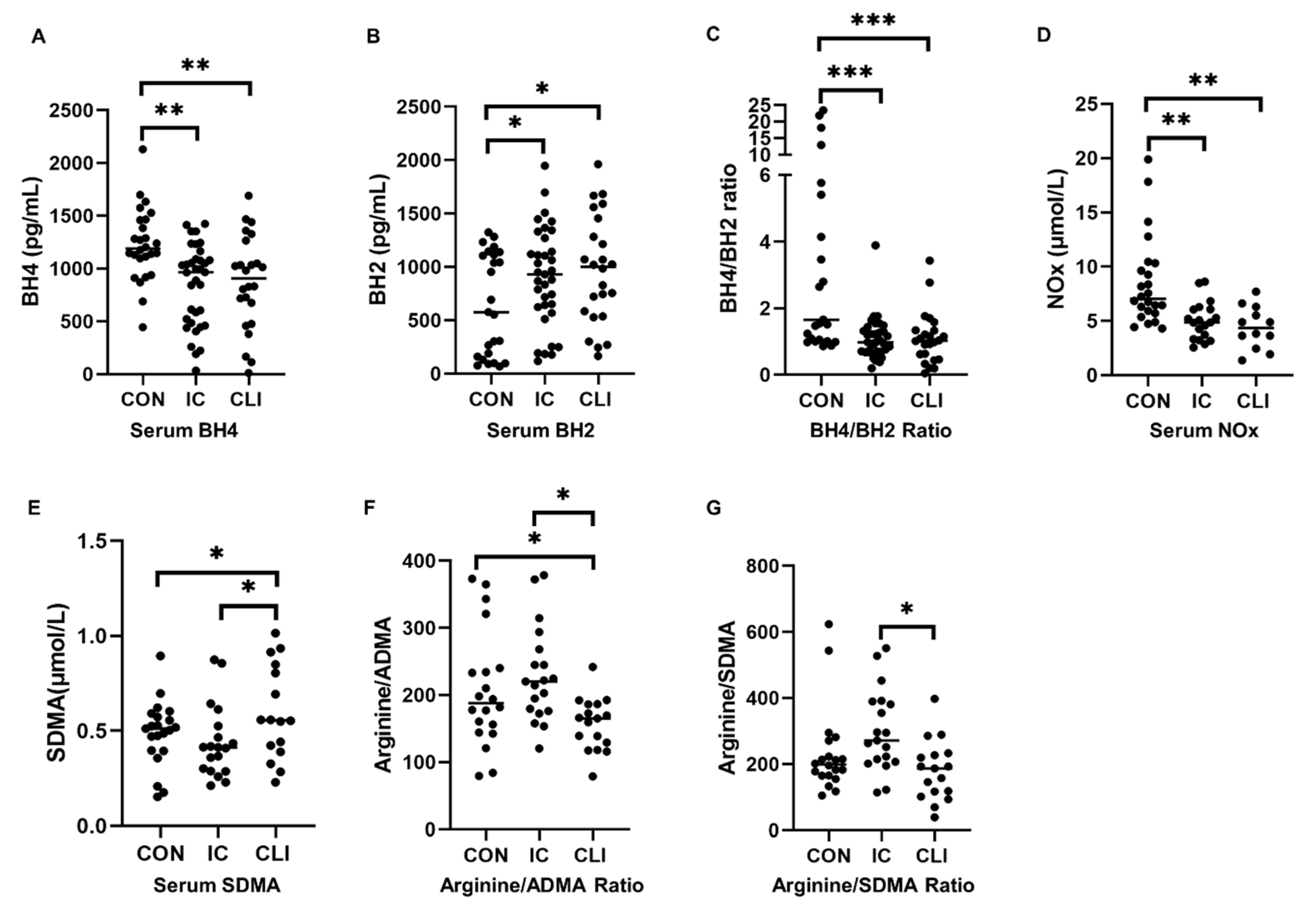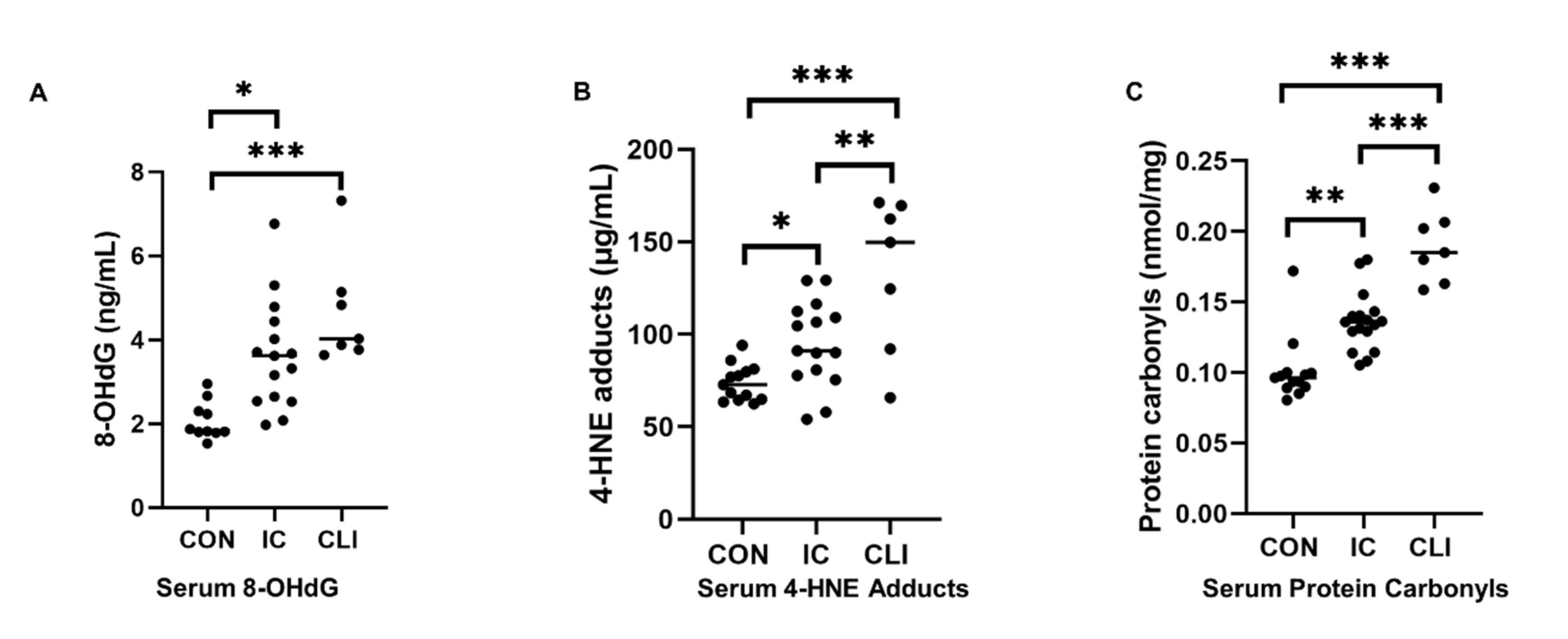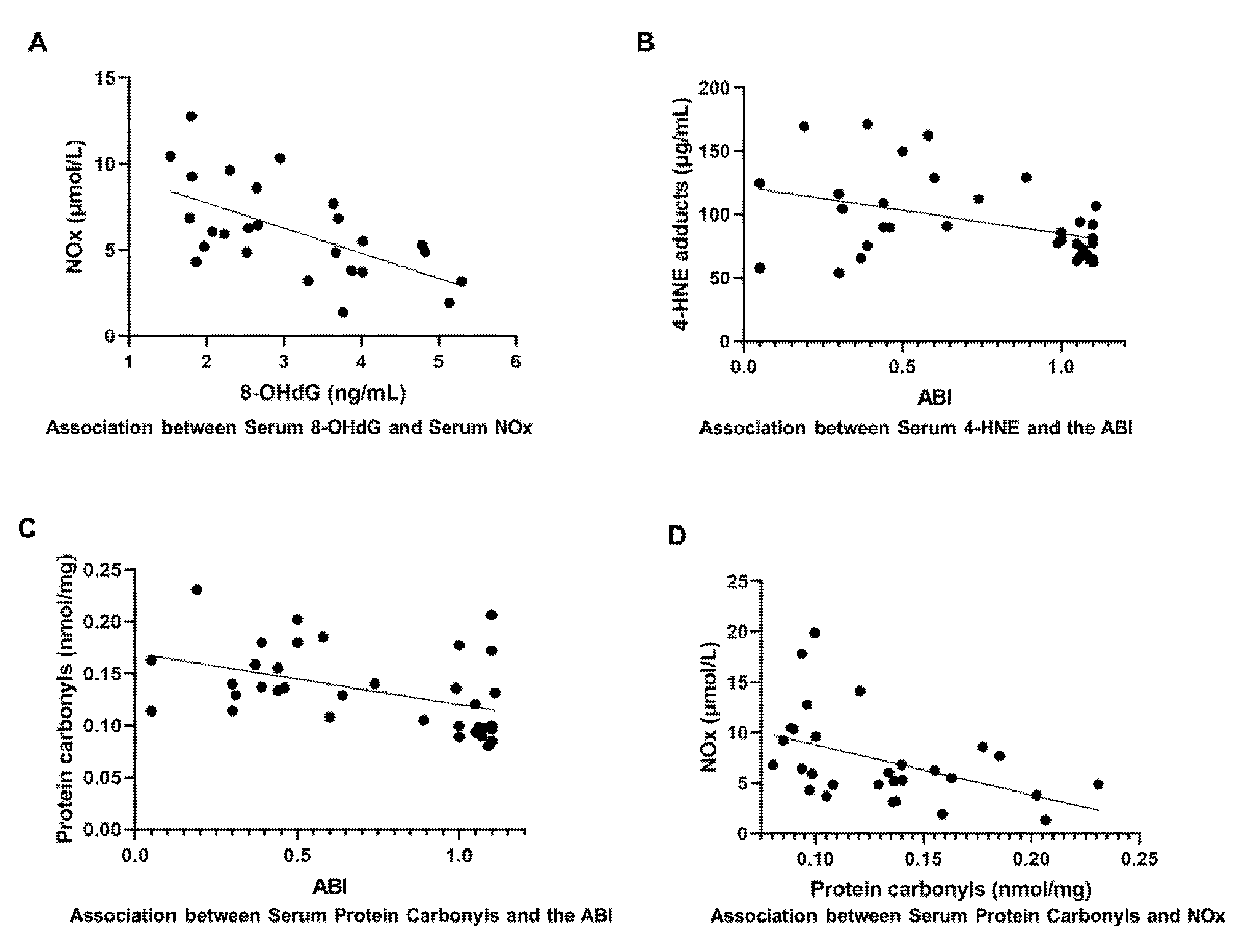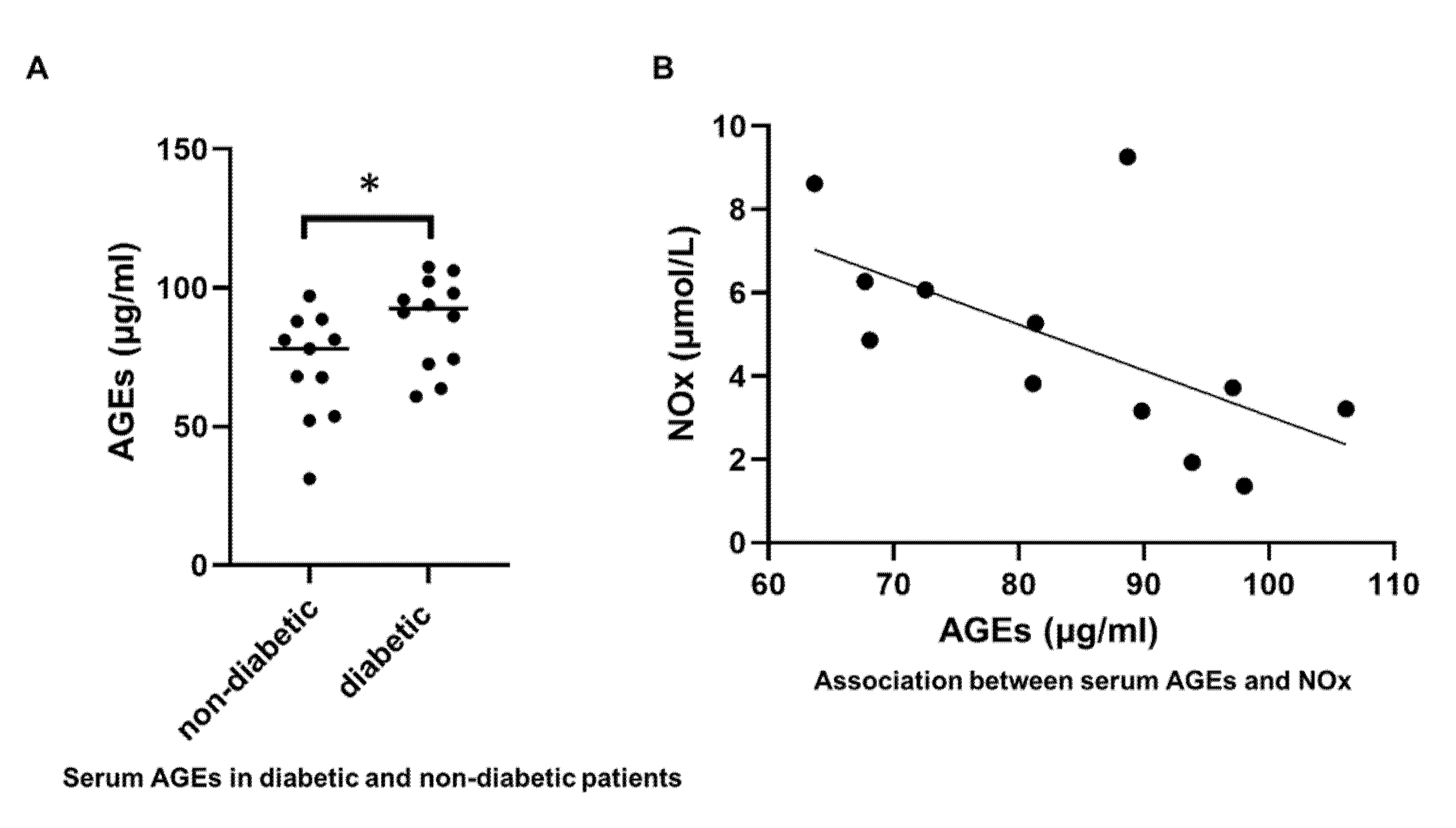The Nitric Oxide System in Peripheral Artery Disease: Connection with Oxidative Stress and Biopterins
Abstract
1. Introduction
2. Materials and Methods
2.1. Study Approval and Participants
2.2. Sample Collection and Preparation
2.3. BH4 and BH2 Determination
2.4. Metabolite Determination
2.5. NOx Determination
2.6. 8-OHdG Assay
2.7. 4-HNE Adducts Assay
2.8. Protein Carbonyl Assay
2.9. Advanced Glycation End Products Assay
2.10. Statistical Analysis
3. Results
3.1. Patient Demographics
3.2. BH4 Concentrations
3.3. BH2 Concentrations
3.4. BH4/BH2 Ratio
3.5. NOx
3.6. Metabolites
3.7. 8-OHdG
3.8. 4-HNE Adducts
3.9. Protein Carbonyls
3.10. AGEs
4. Discussion
5. Conclusions
Author Contributions
Funding
Acknowledgments
Conflicts of Interest
Appendix A
| Control (n = 26) | IC (n = 35) | CLI (n = 24) | p | |
|---|---|---|---|---|
| BH4 (pg/mL) | 1226.16 ± 342.39 | 846.01 ± 384.91 * | 870.04 ± 445.29 * | 0.001 |
| BH2 (pg/mL) | 646.87 ± 478.70 | 907.19 ± 459.56 * | 969.16 ± 508.59 * | 0.045 |
| BH4/BH2 | 5.28 ± 6.71 | 1.08 ± 0.64 * | 1.09 ± 0.78 * | <0.001 |
| Nitrite (µmol/L) | 3.89 ± 3.23 | 3.57 ± 2.32 | 1.54 ± 1.08 * | 0.037 |
| Nitrate (µmol/L) | 4.56 ± 3.01 | 1.72 ± 1.43 * | 2.42 ± 1.59 * | <0.0001 |
| NOx (µmol/L) | 8.49 ± 4.08 | 5.01 ± 1.75 * | 4.40 ± 1.95 * | <0.0001 |
| Arginine (µmol/L) | 107.84 ± 33.88 | 113.51 ± 21.77 | 94.28 ± 23.55 | 0.106 |
| Citrulline (µmol/L) | 31.98 ± 12.18 | 32.57 ± 14.08 | 38.47 ± 24.42 | 0.461 |
| ADMA (µmol/L) | 0.56 ± 0.17 | 0.52 ± 0.10 | 0.62 ± 0.15 | 0.134 |
| SDMA (µmol/L) | 0.49 ± 0.17 | 0.44 ± 0.19 | 0.66 ± 0.35 *,† | 0.026 |
| Arginine/ADMA | 206.82 ± 86.1 | 229.23 ± 70.56 | 157.05 ± 38.94 *,† | 0.01 |
| Arginine/SDMA | 257.32 ± 168.51 | 300.34 ± 124.14 | 180.38 ± 90.93 † | 0.033 |
| 8-OHdG (ng/mL) | 2.53 ± 1.07 | 3.63 ± 1.29 * | 4.65 ± 1.30 * | 0.002 |
| 4-HNE adducts (µg/mL) | 73.79 ± 9.81 | 94.96 ± 23.19 * | 133.64 ± 41.27 *,† | <0.0001 |
| Protein carbonyls (nmol/mg) | 0.10 ± 0.02 | 0.13 ± 0.04 * | 0.19 ± 0.03 *,† | <0.0001 |
References
- Kullo, I.J.; Rooke, T.W. Clinical Practice. Peripheral Artery Disease. N. Engl. J. Med. 2016, 374, 861–871. [Google Scholar] [CrossRef] [PubMed]
- Gerhard-Herman, M.D.; Gornik, H.L.; Barrett, C.; Barshes, N.R.; Corriere, M.A.; Drachman, D.E.; Fleisher, L.A.; Fowkes, F.G.; Hamburg, N.M.; Kinlay, S.; et al. 2016 AHA/ACC Guideline on the Management of Patients with Lower Extremity Peripheral Artery Disease: Executive Summary: A Report of the American College of Cardiology/American Heart Association Task Force on Clinical Practice Guidelines. Circulation 2017, 135, e686–e725. [Google Scholar] [CrossRef]
- Pipinos, I.I.; Judge, A.R.; Selsby, J.T.; Zhu, Z.; Swanson, S.A.; Nella, A.A.; Dodd, S.L. The myopathy of peripheral arterial occlusive disease: Part 1. Functional and histomorphological changes and evidence for mitochondrial dysfunction. Vasc. Endovasc. Surg. 2007, 41, 481–489. [Google Scholar] [CrossRef] [PubMed]
- Grenon, S.M.; Chong, K.; Alley, H.; Nosova, E.; Gasper, W.; Hiramoto, J.; Boscardin, W.J.; Owens, C.D. Walking disability in patients with peripheral artery disease is associated with arterial endothelial function. J. Vasc. Surg. 2014, 59, 1025–1034. [Google Scholar] [CrossRef] [PubMed]
- Green, D.J.; Dawson, E.A.; Groenewoud, H.M.; Jones, H.; Thijssen, D.H. Is flow-mediated dilation nitric oxide mediated? A meta-analysis. Hypertension 2014, 63, 376–382. [Google Scholar] [CrossRef]
- Coutinho, T.; Rooke, T.W.; Kullo, I.J. Arterial dysfunction and functional performance in patients with peripheral artery disease: A review. Vasc. Med. 2011, 16, 203–211. [Google Scholar] [CrossRef]
- Brevetti, G.; Silvestro, A.; Schiano, V.; Chiariello, M. Endothelial dysfunction and cardiovascular risk prediction in peripheral arterial disease: Additive value of flow-mediated dilation to ankle-brachial pressure index. Circulation 2003, 108, 2093–2098. [Google Scholar] [CrossRef]
- Gokce, N.; Keaney, J.F., Jr.; Hunter, L.M.; Watkins, M.T.; Nedeljkovic, Z.S.; Menzoian, J.O.; Vita, J.A. Predictive value of noninvasively determined endothelial dysfunction for long-term cardiovascular events in patients with peripheral vascular disease. J. Am. Coll. Cardiol 2003, 41, 1769–1775. [Google Scholar] [CrossRef]
- Higashi, Y.; Noma, K.; Yoshizumi, M.; Kihara, Y. Endothelial function and oxidative stress in cardiovascular diseases. Circ. J. Off. J. Jpn. Circ. Soc. 2009, 73, 411–418. [Google Scholar] [CrossRef]
- Steven, S.; Daiber, A.; Dopheide, J.F.; Munzel, T.; Espinola-Klein, C. Peripheral artery disease, redox signaling, oxidative stress-Basic and clinical aspects. Redox Biol. 2017, 12, 787–797. [Google Scholar] [CrossRef]
- Tejero, J.; Stuehr, D. Tetrahydrobiopterin in nitric oxide synthase. IUBMB Life 2013, 65, 358–365. [Google Scholar] [CrossRef] [PubMed]
- Crabtree, M.J.; Channon, K.M. Synthesis and recycling of tetrahydrobiopterin in endothelial function and vascular disease. Nitric Oxide Biol. Chem. 2011, 25, 81–88. [Google Scholar] [CrossRef] [PubMed]
- Crabtree, M.J.; Hale, A.B.; Channon, K.M. Dihydrofolate reductase protects endothelial nitric oxide synthase from uncoupling in tetrahydrobiopterin deficiency. Free Radic. Biol. Med. 2011, 50, 1639–1646. [Google Scholar] [CrossRef]
- Stroes, E.; Hijmering, M.; Van Zandvoort, M.; Wever, R.; Rabelink, T.J.; Van Faassen, E.E. Origin of superoxide production by endothelial nitric oxide synthase. FEBS Lett. 1998, 438, 161–164. [Google Scholar] [CrossRef]
- Channon, K.M. Tetrahydrobiopterin: A Vascular Redox Target to Improve Endothelial Function. Curr. Vasc. Pharmacol. 2012, 10, 705–708. [Google Scholar] [CrossRef] [PubMed]
- Crabtree, M.J.; Tatham, A.L.; Al-Wakeel, Y.; Warrick, N.; Hale, A.B.; Cai, S.; Channon, K.M.; Alp, N.J. Quantitative regulation of intracellular endothelial nitric-oxide synthase (eNOS) coupling by both tetrahydrobiopterin-eNOS stoichiometry and biopterin redox status: Insights from cells with tet-regulated GTP cyclohydrolase I expression. J. Biol. Chem. 2009, 284, 1136–1144. [Google Scholar] [CrossRef]
- Ismaeel, A.; Franco, M.E.; Lavado, R.; Papoutsi, E.; Casale, G.P.; Fuglestad, M.; Mietus, C.J.; Haynatzki, G.R.; Smith, R.S.; Bohannon, W.T.; et al. Altered Metabolomic Profile in Patients with Peripheral Artery Disease. J. Clin. Med. 2019, 8, 1463. [Google Scholar] [CrossRef]
- Ormstad, H.; Verkerk, R.; Sandvik, L. Serum Phenylalanine, Tyrosine, and their Ratio in Acute Ischemic Stroke: On the Trail of a Biomarker? J. Mol. Neurosci. 2016, 58, 102–108. [Google Scholar] [CrossRef]
- Vallance, P.; Leone, A.; Calver, A.; Collier, J.; Moncada, S. Accumulation of an endogenous inhibitor of nitric oxide synthesis in chronic renal failure. Lancet 1992, 339, 572–575. [Google Scholar] [CrossRef]
- Bode-Boger, S.M.; Scalera, F.; Kielstein, J.T.; Martens-Lobenhoffer, J.; Breithardt, G.; Fobker, M.; Reinecke, H. Symmetrical dimethylarginine: A new combined parameter for renal function and extent of coronary artery disease. J. Am. Soc. Nephrol. 2006, 17, 1128–1134. [Google Scholar] [CrossRef]
- Giovannoni, G.; Land, J.M.; Keir, G.; Thompson, E.J.; Heales, S.J. Adaptation of the nitrate reductase and Griess reaction methods for the measurement of serum nitrate plus nitrite levels. Ann. Clin. Biochem. 1997, 34 Pt 2, 193–198. [Google Scholar] [CrossRef]
- Signorelli, S.S.; Scuto, S.; Marino, E.; Xourafa, A.; Gaudio, A. Oxidative Stress in Peripheral Arterial Disease (PAD) Mechanism and Biomarkers. Antioxidants 2019, 8, 367. [Google Scholar] [CrossRef] [PubMed]
- Singh, V.P.; Bali, A.; Singh, N.; Jaggi, A.S. Advanced glycation end products and diabetic complications. Korean J. Physiol. Pharm. 2014, 18, 1–14. [Google Scholar] [CrossRef] [PubMed]
- Koutakis, P.; Ismaeel, A.; Farmer, P.; Purcell, S.; Smith, R.S.; Eidson, J.L.; Bohannon, W.T. Oxidative stress and antioxidant treatment in patients with peripheral artery disease. Physiol. Rep. 2018, 6, e13650. [Google Scholar] [CrossRef] [PubMed]
- Pipinos, I.I.; Judge, A.R.; Zhu, Z.; Selsby, J.T.; Swanson, S.A.; Johanning, J.M.; Baxter, B.T.; Lynch, T.G.; Dodd, S.L. Mitochondrial defects and oxidative damage in patients with peripheral arterial disease. Free Radic. Biol. Med. 2006, 41, 262–269. [Google Scholar] [CrossRef] [PubMed]
- Edwards, A.T.; Blann, A.D.; Suarez-Mendez, V.J.; Lardi, A.M.; McCollum, C.N. Systemic responses in patients with intermittent claudication after treadmill exercise. Br. J. Surg. 1994, 81, 1738–1741. [Google Scholar] [CrossRef]
- Langlois, M.; Duprez, D.; Delanghe, J.; De Buyzere, M.; Clement, D.L. Serum vitamin C concentration is low in peripheral arterial disease and is associated with inflammation and severity of atherosclerosis. Circulation 2001, 103, 1863–1868. [Google Scholar] [CrossRef]
- Gardner, A.W.; Montgomery, P.S.; Zhao, Y.D.; Silva-Palacios, F.; Ungvari, Z.; Csiszar, A.; Sonntag, W.E. Association between daily walking and antioxidant capacity in patients with symptomatic peripheral artery disease. J. Vasc. Surg. 2017, 65, 1762–1768. [Google Scholar] [CrossRef]
- Weiss, D.J.; Casale, G.P.; Koutakis, P.; Nella, A.A.; Swanson, S.A.; Zhu, Z.; Miserlis, D.; Johanning, J.M.; Pipinos, I.I. Oxidative damage and myofiber degeneration in the gastrocnemius of patients with peripheral arterial disease. J. Transl. Med. 2013, 11, 230. [Google Scholar] [CrossRef]
- Loffredo, L.; Marcoccia, A.; Pignatelli, P.; Andreozzi, P.; Borgia, M.C.; Cangemi, R.; Chiarotti, F.; Violi, F. Oxidative-stress-mediated arterial dysfunction in patients with peripheral arterial disease. Eur. Heart J. 2007, 28, 608–612. [Google Scholar] [CrossRef]
- Madaric, J.; Valachovicova, M.; Paulis, L.; Pribojova, J.; Mateova, R.; Sebekova, K.; Postulkova, L.; Madaricova, T.; Bucova, M.; Mistrik, M.; et al. Improvement in asymmetric dimethylarginine and oxidative stress in patients with limb salvage after autologous mononuclear stem cell application for critical limb ischemia. Stem Cell Res. Ther. 2017, 8, 165. [Google Scholar] [CrossRef] [PubMed]
- Cooke, J.P.; Ghebremariam, Y.T. DDAH Says NO to ADMA. Arterioscler. Thromb. Vasc. Biol. 2011, 31, 1462–1464. [Google Scholar] [CrossRef] [PubMed]
- Schlesinger, S.; Sonntag, S.R.; Lieb, W.; Maas, R. Asymmetric and Symmetric Dimethylarginine as Risk Markers for Total Mortality and Cardiovascular Outcomes: A Systematic Review and Meta-Analysis of Prospective Studies. Atherosclerosis 2017, 263, E136. [Google Scholar] [CrossRef][Green Version]
- Wang, J.; Sim, A.S.; Wang, X.L.; Salonikas, C.; Naidoo, D.; Wilcken, D.E.L. Relations between plasma asymmetric dimethylarginine (ADMA) and risk factors for coronary disease. Atherosclerosis 2006, 184, 383–388. [Google Scholar] [CrossRef]
- Tain, Y.L.; Hsu, C.N. Toxic Dimethylarginines: Asymmetric Dimethylarginine (ADMA) and Symmetric Dimethylarginine (SDMA). Toxins 2017, 9, 92. [Google Scholar] [CrossRef]
- Jud, P.; Hafner, F.; Verheyen, N.; Meinitzer, A.; Gary, T.; Brodmann, M.; Seinost, G.; Hackl, G. Homoarginine/ADMA ratio and homoarginine/SDMA ratio as independent predictors of cardiovascular mortality and cardiovascular events in lower extremity arterial disease. Sci. Rep. 2018, 8, 14197. [Google Scholar] [CrossRef]
- Bierhaus, A.; Humpert, P.M.; Morcos, M.; Wendt, T.; Chavakis, T.; Arnold, B.; Stern, D.M.; Nawroth, P.P. Understanding RAGE, the receptor for advanced glycation end products. J. Mol. Med. 2005, 83, 876–886. [Google Scholar] [CrossRef]
- De Vos, L.C.; Mulder, D.J.; Smit, A.J.; Dullaart, R.P.F.; Kleefstra, N.; Lijfering, W.M.; Kamphuisen, P.W.; Zeebregts, C.J.; Lefrandt, J.D. Skin autofluorescence is associated with 5-year mortality and cardiovascular events in patients with peripheral artery disease. Arterioscler. Thromb. Vasc. Biol. 2014, 34, 933–938. [Google Scholar] [CrossRef]
- Nowotny, K.; Jung, T.; Hohn, A.; Weber, D.; Grune, T. Advanced glycation end products and oxidative stress in type 2 diabetes mellitus. Biomolecules 2015, 5, 194–222. [Google Scholar] [CrossRef]
- Lapolla, A.; Piarulli, F.; Sartore, G.; Ceriello, A.; Ragazzi, E.; Reitano, R.; Baccarin, L.; Laverda, B.; Fedele, D. Advanced glycation end products and antioxidant status in type 2 diabetic patients with and without peripheral artery disease. Diabetes Care 2007, 30, 670–676. [Google Scholar] [CrossRef]
- De Vos, L.C.; Boersema, J.; Mulder, D.J.; Smit, A.J.; Zeebregts, C.J.; Lefrandt, J.D. Skin autofluorescence as a measure of advanced glycation end products deposition predicts 5-year amputation in patients with peripheral artery disease. Arterioscler. Thromb. Vasc. Biol. 2015, 35, 1532–1537. [Google Scholar] [CrossRef] [PubMed]
- De Vos, L.C.; Lefrandt, J.D.; Dullaart, R.P.F.; Zeebregts, C.J.; Smit, A.J. Advanced glycation end products: An emerging biomarker for adverse outcome in patients with peripheral artery disease. Atherosclerosis 2016, 254, 291–299. [Google Scholar] [CrossRef]
- McDermott, M.M. Functional impairment in peripheral artery disease and how to improve it in 2013. Curr. Cardiol. Rep. 2013, 15, 347. [Google Scholar] [CrossRef] [PubMed]
- Myers, S.A.; Johanning, J.M.; Stergiou, N.; Lynch, T.G.; Longo, G.M.; Pipinos, I.I. Claudication distances and the Walking Impairment Questionnaire best describe the ambulatory limitations in patients with symptomatic peripheral arterial disease. J. Vasc. Surg. 2008, 47, 550–555. [Google Scholar] [CrossRef] [PubMed][Green Version]
- Roset, P.N. Systematic review of the efficacy of cilostazol, naftidrofuryl oxalate and pentoxifylline for the treatment of intermittent claudication (Br J Surg 2012; 99: 1630–1638). Br. J. Surg. 2013, 100, 1838. [Google Scholar] [CrossRef] [PubMed]
- Salhiyyah, K.; Forster, R.; Senanayake, E.; Abdel-Hadi, M.; Booth, A.; Michaels, J.A. Pentoxifylline for intermittent claudication. Cochrane Database Syst. Rev. 2015, 9, CD005262. [Google Scholar] [CrossRef]
- Norgren, L.; Hiatt, W.R.; Dormandy, J.A.; Nehler, M.R.; Harris, K.A.; Fowkes, F.G.; Group, T.I.W. Inter-Society Consensus for the Management of Peripheral Arterial Disease (TASC II). J. Vasc. Surg. 2007, 45, S5–S67. [Google Scholar] [CrossRef]
- Dawson, D.L.; Cutler, B.S.; Hiatt, W.R.; Hobson, R.W., 2nd; Martin, J.D.; Bortey, E.B.; Forbes, W.P.; Strandness, D.E., Jr. A comparison of cilostazol and pentoxifylline for treating intermittent claudication. Am. J. Med. 2000, 109, 523–530. [Google Scholar] [CrossRef]
- McDermott, M.M.; Polonsky, T.S. Home-Based Exercise: A Therapeutic Option for Peripheral Artery Disease. Circulation 2016, 134, 1127–1129. [Google Scholar] [CrossRef]
- Brass, E.P.; Hiatt, W.R. Acquired skeletal muscle metabolic myopathy in atherosclerotic peripheral arterial disease. Vasc. Med. 2000, 5, 55–59. [Google Scholar] [CrossRef]
- Hiatt, W.R.; Regensteiner, J.G.; Hargarten, M.E.; Wolfel, E.E.; Brass, E.P. Benefit of exercise conditioning for patients with peripheral arterial disease. Circulation 1990, 81, 602–609. [Google Scholar] [CrossRef] [PubMed]
- Hess, C.N.; Norgren, L.; Ansel, G.M.; Capell, W.H.; Fletcher, J.P.; Fowkes, F.G.R.; Gottsater, A.; Hitos, K.; Jaff, M.R.; Nordanstig, J.; et al. A Structured Review of Antithrombotic Therapy in Peripheral Artery Disease with a Focus on Revascularization: A TASC (InterSociety Consensus for the Management of Peripheral Artery Disease) Initiative. Circulation 2017, 135, 2534–2555. [Google Scholar] [CrossRef]
- Secemsky, E.A.; Schermerhorn, M.; Carroll, B.J.; Kennedy, K.F.; Shen, C.; Valsdottir, L.R.; Landon, B.; Yeh, R.W. Readmissions After Revascularization Procedures for Peripheral Arterial Disease: A Nationwide Cohort Study. Ann. Intern. Med. 2018, 168, 93–99. [Google Scholar] [CrossRef] [PubMed]
- Ismaeel, A.; Lavado, R.; Smith, R.S.; Eidson, J.L.; Sawicki, I.; Kirk, J.S.; Bohannon, W.T.; Koutakis, P. Effects of Limb Revascularization Procedures on Oxidative Stress. J. Surg. Res. 2018, 232, 503–509. [Google Scholar] [CrossRef] [PubMed]
- Pieper, G.M. Acute amelioration of diabetic endothelial dysfunction with a derivative of the nitric oxide synthase cofactor, tetrahydrobiopterin. J. Cardiovasc. Pharmacol. 1997, 29, 8–15. [Google Scholar] [CrossRef] [PubMed]
- Maier, W.; Cosentino, F.; Lutolf, R.B.; Fleisch, M.; Seiler, C.; Hess, O.M.; Meier, B.; Luscher, T.F. Tetrahydrobiopterin improves endothelial function in patients with coronary artery disease. J. Cardiovasc. Pharmacol. 2000, 35, 173–178. [Google Scholar] [CrossRef]
- Heitzer, T.; Brockhoff, C.; Mayer, B.; Warnholtz, A.; Mollnau, H.; Henne, S.; Meinertz, T.; Munzel, T. Tetrahydrobiopterin improves endothelium-dependent vasodilation in chronic smokers-Evidence for a dysfunctional nitric oxide synthase. Circ. Res. 2000, 86, E36–E41. [Google Scholar] [CrossRef]
- Hurlimann, D.; Noll, G.; Chenevard, R.; Eto, M.; Enseleit, F.; Blau, N.; Luscher, T.F.; Cosentino, F. Oral treatment with tetrahydrobiopterin reverses endothelial dysfunction and oxidative stress in hypercholesterolemia. Eur. Heart J. 2005, 26, 260. [Google Scholar]
- Bendall, J.K.; Douglas, G.; McNeill, E.; Channon, K.M.; Crabtree, M.J. Tetrahydrobiopterin in cardiovascular health and disease. Antioxid. Redox Signal. 2014, 20, 3040–3077. [Google Scholar] [CrossRef]
- Murohara, T.; Asahara, T.; Silver, M.; Bauters, C.; Masuda, H.; Kalka, C.; Kearney, M.; Chen, D.; Symes, J.F.; Fishman, M.C.; et al. Nitric oxide synthase modulates angiogenesis in response to tissue ischemia. J. Clin. Investig. 1998, 101, 2567–2578. [Google Scholar] [CrossRef]
- Marinos, R.S.; Zhang, W.; Wu, G.; Kelly, K.A.; Meininger, C.J. Tetrahydrobiopterin levels regulate endothelial cell proliferation. Am. J. Physiol. Heart Circ. Physiol. 2001, 281, H482–H489. [Google Scholar] [CrossRef] [PubMed]
- Shimizu, S.; Yasuda, M.; Ishii, M.; Nagai, T.; Kiuchi, Y.; Yamamoto, T. Stimulation of in vitro angiogenesis by tetrahydrobiopterin in bovine aortic endothelial cells. Jpn. J. Pharm. 1999, 80, 177–180. [Google Scholar] [CrossRef] [PubMed][Green Version]
- Clot, F.; Grabli, D.; Cazeneuve, C.; Roze, E.; Castelnau, P.; Chabrol, B.; Landrieu, P.; Nguyen, K.; Ponsot, G.; Abada, M.; et al. Exhaustive analysis of BH4 and dopamine biosynthesis genes in patients with Dopa-responsive dystonia. Brain 2009, 132, 1753–1763. [Google Scholar] [CrossRef] [PubMed]
- Cronin, S.J.F.; Seehus, C.; Weidinger, A.; Talbot, S.; Reissig, S.; Seifert, M.; Pierson, Y.; McNeill, E.; Longhi, M.S.; Turnes, B.L.; et al. The metabolite BH4 controls T cell proliferation in autoimmunity and cancer. Nature 2018, 563, 564–568. [Google Scholar] [CrossRef]
- Bailey, J.; Shaw, A.; Fischer, R.; Ryan, B.J.; Kessler, B.M.; McCullagh, J.; Wade-Martins, R.; Channon, K.M.; Crabtree, M.J. A novel role for endothelial tetrahydrobiopterin in mitochondrial redox balance. Free Radic. Biol. Med. 2017, 104, 214–225. [Google Scholar] [CrossRef]
- Loffredo, L.; Pignatelli, P.; Cangemi, R.; Andreozzi, P.; Panico, M.A.; Meloni, V.; Violi, F. Imbalance between nitric oxide generation and oxidative stress in patients with peripheral arterial disease: Effect of an antioxidant treatment. J. Vasc. Surg. 2006, 44, 525–530. [Google Scholar] [CrossRef]
- Loffredo, L.; Perri, L.; Catasca, E.; Pignatelli, P.; Brancorsini, M.; Nocella, C.; De Falco, E.; Bartimoccia, S.; Frati, G.; Carnevale, R.; et al. Dark chocolate acutely improves walking autonomy in patients with peripheral artery disease. J. Am. Heart Assoc. 2014, 3. [Google Scholar] [CrossRef]




| Control (n = 35) | IC (n = 35) | CLI (n = 26) | p | |
|---|---|---|---|---|
| Age (years) | 62.11 ± 7.83 | 62.71 ± 8.93 | 64.54 ± 9.35 | 0.544 |
| Male sex (%) | 72.2% | 86.8% | 84.6% | 0.466 |
| ABI | 1.08 ± 0.05 | 0.55 ± 0.25 | 0.27 ± 0.28 | <0.001 |
| Risk factors (%) | ||||
| Tobacco use | 0.005 | |||
| Current | 24% | 43.2% | 50.0% | |
| Never | 40% | 5.7% | 30.8% | |
| Former | 36% | 51.4% | 19.2% | |
| Hypertension | 68% | 82.9% | 88.5% | 0.164 |
| Diabetes mellitus | 16% | 34.3% | 57.7% | 0.008 |
| Coronary artery disease | 28% | 37.1% | 46.2% | 0.407 |
| Obesity | 40.0% | 20.0% | 19.2% | 0.146 |
| Dyslipidemia | 76.0% | 68.6% | 57.7% | 0.372 |
© 2020 by the authors. Licensee MDPI, Basel, Switzerland. This article is an open access article distributed under the terms and conditions of the Creative Commons Attribution (CC BY) license (http://creativecommons.org/licenses/by/4.0/).
Share and Cite
Ismaeel, A.; Papoutsi, E.; Miserlis, D.; Lavado, R.; Haynatzki, G.; Casale, G.P.; Bohannon, W.T.; Smith, R.S.; Eidson, J.L.; Brumberg, R.; et al. The Nitric Oxide System in Peripheral Artery Disease: Connection with Oxidative Stress and Biopterins. Antioxidants 2020, 9, 590. https://doi.org/10.3390/antiox9070590
Ismaeel A, Papoutsi E, Miserlis D, Lavado R, Haynatzki G, Casale GP, Bohannon WT, Smith RS, Eidson JL, Brumberg R, et al. The Nitric Oxide System in Peripheral Artery Disease: Connection with Oxidative Stress and Biopterins. Antioxidants. 2020; 9(7):590. https://doi.org/10.3390/antiox9070590
Chicago/Turabian StyleIsmaeel, Ahmed, Evlampia Papoutsi, Dimitrios Miserlis, Ramon Lavado, Gleb Haynatzki, George P. Casale, William T. Bohannon, Robert S. Smith, Jack Leigh Eidson, Robert Brumberg, and et al. 2020. "The Nitric Oxide System in Peripheral Artery Disease: Connection with Oxidative Stress and Biopterins" Antioxidants 9, no. 7: 590. https://doi.org/10.3390/antiox9070590
APA StyleIsmaeel, A., Papoutsi, E., Miserlis, D., Lavado, R., Haynatzki, G., Casale, G. P., Bohannon, W. T., Smith, R. S., Eidson, J. L., Brumberg, R., Hayson, A., Kirk, J. S., Castro, C., Sawicki, I., Konstantinou, C., Brewster, L. P., Pipinos, I. I., & Koutakis, P. (2020). The Nitric Oxide System in Peripheral Artery Disease: Connection with Oxidative Stress and Biopterins. Antioxidants, 9(7), 590. https://doi.org/10.3390/antiox9070590









